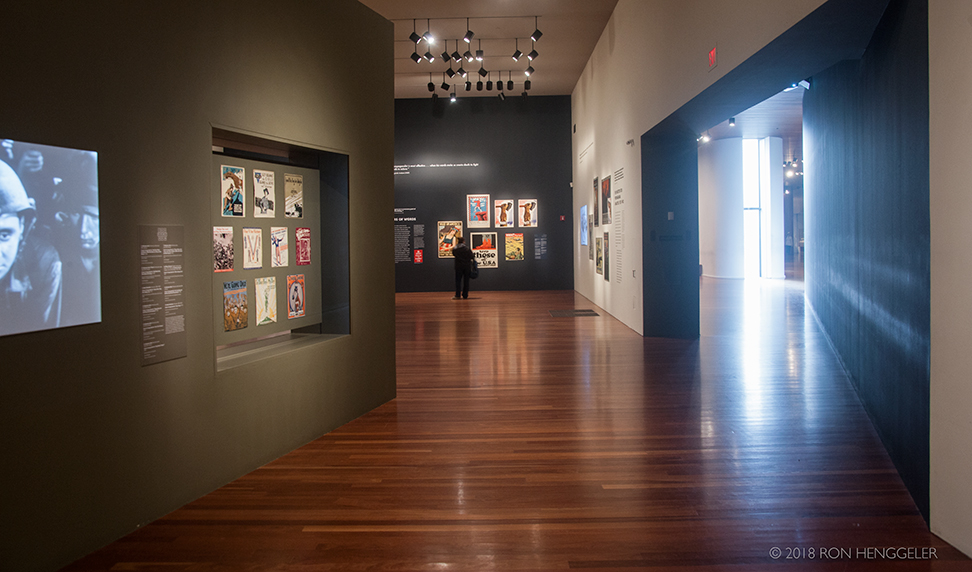RON HENGGELER |
August 20, 2018
Photos from the show at the de Young Museum
Weapons of Mass Seduction: The Art of Propaganda
May 5, 2018 - October 7, 2018
Today a single tweet can reach millions of people instantaneously, but prior to the internet age, the mechanics of shaping public opinion by spreading information and ideas was more regulated, hierarchical, and specialized. For instance, during the First World War, complex military operations were needed to drop propaganda leaflet bombs from airplanes, saturating the landscape with paper messages targeting enemy soldiers and civilians. Ephemeral printed materials, in addition to radio broadcasts and motion pictures, were the primary vehicles of propaganda during the first half of the twentieth century. Among the most powerful tools of psychological warfare, propaganda posters weaponized the art of graphic design.
As international hostilities erupted during the 1910s and again in the 1930s, the American government and its foreign counterparts sought effective channels of communication with the public. Centralized bureaus—like the Committee on Public Information in the United States, the Ministry of Information in Great Britain, and the Reich Ministry of Popular Enlightenment and Propaganda in Germany—looked to the worlds of art and advertising, recruiting painters, professional illustrators, and filmmakers to tell their stories.
From: de Young Museum
Jazz in a cat-trance on Sunday morning |
The bronze statue of John McClaren in the John McLaren Memorial Rhododendron Dell.Golden Gate Park superintendent John McLaren HATED statues.He fought city officials every time they wanted to place a statue in his park. When he lost the fight, he would send his men to hide the offending monument by planting trees, shrubs and vines around it, obscuring the view. Perhaps out of reverence, or perhaps as a snarky joke, on his 65th birthday McLaren was presented with a life size statue of himself.Horrified, he hid it in a box and it was not seen again until after he died.In 1943, the statue was taken out of storage and put on display at the back of the John McLaren Memorial Rhododendron Dell.Three things should be observed about the statue: Unlike every other statue in the park, McLaren’s likeness stands directly on the ground instead of on a pedestal, this was to symbolize his closeness with nature. He holds a pine cone in his hand, a symbol of the over 2 million trees he planted in the Golden Gate Park.Finally, the saw marks on McLaren’s right leg are from the second of two unsuccessful attempts to steal the statue in 1953. In the first attempt the assailants attempted to pry the statue from its base.From: Atlas Obscura |
The statue of John McClaren is by sculptor Melvin Earl Cummings (1876-1936) |
|
|
|
|
|
|
Weapons of Mass Seduction: The Art of PropagandaMay 5, 2018 - October 7, 2018This exhibition features a selection of World War I and II–era posters from the collection of the Achenbach Foundation for Graphic Arts, shown alongside films, ephemera, and textiles from the 1910s to the 1940s. The design and content of these works demonstrate consistent strategies for selling ideas and manipulating public opinion that persist to the present day.From: de Young Museum |
|
|
|
|
|
|
|
|
|
|
|
|
|
|
|
|
Text |
|
|
|
|
|
|
|
|
|
|
|
|
|
|
|
|
|
|
|
|
|
|
|
|
|
|
|
|
|
|
|
|
|
|
|
|
|
|
|
|
|
|
|
|
|
|
|
|
|
|
|
|
|
|
|
|
|
|
|
|
|
|
|
|
|
|
|
|
|
|
|
|
|
In 1937, a group of academics based at Columbia University founded the Institute for Propaganda Analysis to educate the America public on the techniques of domestic propaganda. Although this institute ceased operations shortly after the US entry into World War II, its findings are still commonly cited in studies of advertising and political campaigns. |
One of the most potent propaganda techniques the Institute for Propaganda Analysis identified in 1937 was “Card Stacking,” which seeks to manipulate audience perception of an issue by emphasizing one side and repressing another. In stacking the cards against the truth:[The propagandist] uses under-emphasis and over-emphasis to dodge issues and evade facts. He omits facts. He offers false testimony . . . He creates a smoke screen of clamor by raising a new issue when he wants an embarrassing matter forgotten. He draws a red herring across the trail to confuse and divert those in quest of facts he does not want revealed. He makes the unreal appear real and the real appear unreal . . . he lets half-truth masquerade as truth. By the card stacking device, a mediocre candidate, through the “build-up,” is made to appear an intellectual titan.The institute publicized other common rhetorical devices employed by propagandists, including Name Calling (using terms such as fascist, red, alien, and muckraker); Glittering Generalities (using virtuous terms like truth, freedom, and the American Way; Transfer (aligning one’s argument with a prestigious authority such as the church), Testimonial (false endorsements), the Bandwagon (pressuring the public to join or be left out) and Plain Folks (affecting the language and customs of ordinary citizens).Previously neutral, the term “propaganda” developed a stigma as an inherently undemocratic technique associated with totalitarian regimes.This text, accompying the last two photos above, is the opening statement printed on the wall near the entrance to the show, Weapons of Mass Seduction: The Art of Propaganda, currently on display at the De Young Museum until October 7, 2018.(Pairing this text with a photo of Trump hugging the flag is entirely my doing, and not necessarily the opinion of the de Young, or of the curators associated with this show.)
|
Newsletters Index: 2019, 2018, 2017, 2016, 2015, 2014, 2013, 2012, 2011, 2010, 2009, 2008, 2007, 2006
Photography Index | Graphics Index | History Index
Home | Gallery | About Me | Links | Contact
© 2019 All rights reserved.
The images are not in the public domain. They are the sole property of the
artist and may not be reproduced on the Internet, sold, altered, enhanced,
modified by artificial, digital or computer imaging or in any other form
without the express written permission of the artist. Non-watermarked copies of photographs on this site can be purchased by contacting Ron.





































































































